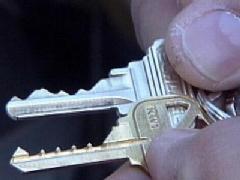Hal Major © 2009
BobVilaContractors.com
What Are Bump Keys?
Bump keys are any key that will slide its full length into a cylinder style pin lock. The grooves on the key are not required to line up with the pins in the tumblers. Lock bumping keys are filed down to create little metal spikes that look like shark teeth on the key. When the key is whacked or hit by the lock-bumping hammer, it pushes up all the pins simultaneously for a split second. When a slight pressure is applied for this split second all the pins are above the tumbler that enables the tumbler to then turn. The hitting or banging of the key with a lock bumping hammer or the grip end of a screwdriver is where the term "lock bumping" comes from.
 Who Invented Bump Keys?
Who Invented Bump Keys?
So far, no one has taken credit for actually coming up with the first bump key. The idea came from Denmark back in the 1970�s. Locksmiths in Denmark shared a technique for knocking or bumping on a lock cylinder while applying slight pressure to the back of the lock plug. The use of a bump key was not introduced until some time later and was first recognized as a potential home security or lock security issue around 2002-2003 in Europe. Now lock bumping keys are sweeping the internet and American homes.
How Vulnerable Is Your Home Security?
If your house locks are cylinder locks using a pin and tumbler mechanism and they are older than a few years, you�re probably vulnerable.
� Over 90% of American homes use an old style cylinder lock, which is vulnerable to lock bumping.
� An 8-year-old child can even bump your home�s door lock.
� Anyone can make a lock-bumping key. Usually in under 5 minutes.
� When a bump key is used to break into your house there is no signs of forced entry or damage to the lock. This makes the insurance companies suspicious and hesitant to paying a claim.
� The internet underworld is jumping about this home security threat. Criminals use the web, too.
Home security experts say it�s time to protect yourself against bump keys and lock-bumping.
How To Protect Your Home�s Security From Lock-Bumping
Take a look at the photo of the top 5 bump keys to see if you recognize your style key. The photo doesn�t represent every bump key for every type of lock that is vulnerable. Just because you don�t see your key style doesn�t mean your locks are immune to bump keys.
 Here�s what you can do improve your home�s security:
Here�s what you can do improve your home�s security:
1) Install a slide-bolt lock. Bump keys work to open locks that are inside the door. They are not effective against slide-bolt locks.
2) Invest in a high-end lock. Premium locks are available that use more complex locking mechanisms, which are less vulnerable to key bumping. Their patented designs also allow manufacturers to limit the number of blank keys available for these locks.
3) Get an alternate type of lock. Electronic, combination, magnetic and rotating-disk locks are all less vulnerable to lock-bumping burglaries.
4) Use a cylinder protector on your door to prevent bump key use. These devices cover the front of the lock to prevent tampering.
5) Upgrade your home security. Consider having a security system and motion detection lights installed to deter potential burglars. Burglars don�t want to be seen or heard.
6) Man�s best friend is a great deterrent. Even a small noisy dog will help protect your home against burglaries. Anything that draws attention to a burglar's activities will encourage him to go elsewhere.
If you�re not certain which style or type of lock to buy, check out our informative article about
Safe and Secure Home Door Locks and for more information on making safety choices for your home, you should call a reputable and bonded locksmith.
You can also find great information about the best door locks from the
Associated Locksmiths of America. FREE Estimates from Security Experts NOW!
